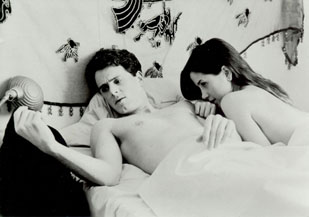Chapter Two: Barcelona
By Brett Beach
February 11, 2010
His three features form a loose thematic trilogy that has been referred to as the "nightlife films" but could also be crudely captured with the tag line "young Americans on the make." All three are set in vaguely specific moments over the last 20 years - Barcelona's title card situates it sometime during "the last decade of the Cold War" - which lends them all an intentional air of nostalgia as well as a fable-like quality. And yet, being set in the recent past dates none of them. This is due to Stillman's refusal to rely solely on the period trappings of costume and music to make the mood and vibe more palpable. There are nightclub scenes in Barcelona and Disco and brief glimpses of the city nightlife just out of reach of the teenagers in Metropolitan, but Stillman wasn't setting out to make an I Love the '80s time trip. His refusal to stop just shy of locating any of the films in a specific year or time helps to open them up that much more. (Roger Avary adopted a similar technique with his adaptation of Bret Easton Ellis' The Rules of Attraction, albeit with the sort of characters who would blowtorch Stillman's Sally Fowler Rat Pack denizens and snort them up in a line of coke.)
Barcelona is not only the middle film, but, surprisingly, the highest grossing of the three. It got the widest release of any of Stillman's films (nearly 300 theaters at its high mark) and grossed nearly $8 million in the summer and fall of '94 against a $3 million budget. Both Metropolitan and Disco accumulated about $3 million each, which was great for the former on a low six-figure production cost, but not as much for the latter, which failed to recoup even half of its financing. I credit Barcelona's success partly on word-of-mouth but also on a poster campaign that smartly put supporting actress Tushka Bergen's visage front and center with the implied promise of sexy fun time not far behind. The uninitiated may have wondered about the two men sitting on steps in the background, one in a suit, the other in a naval officer's uniform and sporting a fine looking eye patch. I could grumble about the poster giving away too much with that image, but a lot of that comes from hindsight, like wondering about the silhouetted frogs poking out from the borders of the early Magnolia poster ads.
Barcelona is also by far the most political, conversely the least universal, and truth be told, the weakest of the three, which again adds to my curiosity at how it wound up grossing the most. I have viewed Disco enough times in the last ten years to validate it in my mind as Stillman's best, but I was curious as to my reaction on checking out Barcelona for the first time in many moons. It can perhaps best be represented as the only film of his with a body count and bodily harm (at least more so than just bruised egos and crushed dreams.)
Continued:
1
2
3
|
|
|
|




